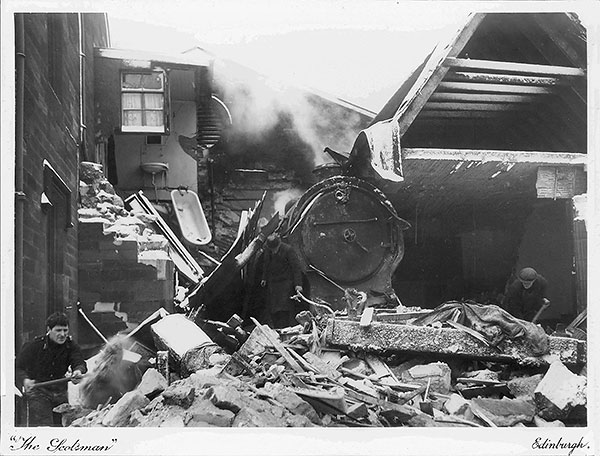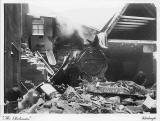|
Railway Accident Musselburgh - 1941 |
|
Question |
|
Alan Grieve has emailed me asking for information about an accident on New Year's Day 1941, when a goods train crashed through the buffers at Musselburgh Station. |
|
Alan wrote: New Year's Day 1941 "I wonder if anyone has any information on the accident at Musselburgh Station on New Year's Day 1941,when a goods train, which appears to have been wrongly diverted onto the Musselburgh Branch at Newhailes Junction, crashed into the bufferstops practically demolishing the bookstall and ended up through the wall of the station." Wreckage "According to a report in the Scotsman the following day the bookstall attendant, 19 year old Canadian Miss Helen Krause, was killed and part of the stationmaster's house collapsed on top of the engine. The heap of wrecked wagons was 30feet high and penetrated the station roof which was holed in two places." Public Inquiry "On 7th March 1941 the Scotsman carried a report of the public inquiry held at Edinburgh Sheriff Court stating that Sheriff Brown had found it impossible to answer with complete clarity the cause of the accident and the persons at fault and he returned a formal verdict. Accident Report "I have been unable to find a formal Accident Report and cannot understand how neither the cause of the accident or the persons at fault had been established. The Musselburgh branch from Newhailes Junction was almost a mile long. There was a strict speed limit on the sharp left hand curve leading onto the Branch and before crossing the river Esk there was a level crossing When a fatality had occurred it would be expected that the Ministry of War Transport would have looked into the incident in great detail and established why the driver claimed to have seen signals for the main line and then was diverted onto the branch, and their report would have been produced and made public. Does anyone have information about the accident or a copy of the report, if there was one produced?" Alan Grieve Minehead, Somerset England: January 23, 2009 |
|
Answer? Being wartime, perhaps the details published were rather limited. However, please email me if you have any information for me to pass on to Alan. Thank you. - Peter Stubbs: January 24, 2009 |
|
Reply 1. Colin Miller |
|
Thank you to Colin Miller who wrote: |
|
Colin wrote: Driver and Fireman "I remember my father talking about the Musselburgh train crash in 1941, many years ago. The crew of the train that crashed were from Tweedmouth Sheds and the driver's name was John (Paddy) Hunter, I'm afraid I don't recall the name of the fireman. Both men were arrested after the accident and charged with manslaughter, or whatever it is referred to in Scotland. I don't think they were ever taken to court as the charges were dropped and both men returned to their duties. I know that Paddy continued to drive up until the time he retired. However, he died some time during the 1950s. I believe that he is survived by a daughter, who lives in Tweedmouth and a son who lives in the Darlington area." |
|
Reply 2. Kevin Graham Berwick-upon-Tweed, Northumberland, England |
|
Thank you to Kevin Graham for providing the following accounts of the accident: |
|
Kevin wrote: Report in the Berwick Advertiser January 9, 1941 "A bookstall attendant was killed on New Year's Day when the engine of a goods train, driven by a Tweedmouth driver and with a Berwick man as fireman, crashed through the buffers at Musselburgh Station, tore up part of the platform, and practically demolished the bookstall. ... The major portion of the bookstall was crushed like matchwood and the engine careered onwards through a stone building containing the stationmaster's office and the porters' room - both, fortunately, unoccupied at the time. The engine finally protruded into the street with a great heap of masonry in front of it. Part of the stationmaster's house above was also damaged. The bathroom collapsed and the bath lay on top of the wreckage. ... The force of the crash caused some of the waggons of the train and their contents to come together in concertina fashion, and then shoot into the air. A heap of wreckage amassed in this way reached a height of about 30 feet and penetrated the station roof, which was holed in two places. Girders holding the roof fell across the platform and lines. ..." Acknowledgement: Kevin Graham, Berwick-upon-Tweed, Northumberland, England Source: Berwick Record Office |
|
Reply 3. Kevin Graham Berwick-upon-Tweed, Northumberland, England |
|
Thank you to Kevin Graham who wrote again, giving further information about the accident. |
|
Kevin wrote: Report in the Berwick Advertiser January 9, 1941 "The driver of the engine was Mr. John Hunter of Main Street, Tweedmouth, and the fireman was Mr. John Welsh, Foul Ford, Berwick. Both escaped injury. The attendant who lost her life, was Miss Ella Krause, aged 19, who lived with an aunt, Miss Pearson, at 2 South Street, Musselburgh. Her parents live in Canada, and she came to live in this country little more than a year ago." Kevin Graham, Berwick-upon-Tweed, Northumberland, England: October 29, 2009 |
|
Reply 4. Johnny Montgomery |
|
Thank you to Johnny Montgomery who wrote: |
|
Death "I remember my mother, Susan McNab Montgomery (née McNab) telling me, years ago, that her sister was killed in this crash when the train mounted the platform. I don't know the name of my mother's sister." Johnny Montgomery: November 13, 2010 |
|
Reply 5. George Moffat Sheffield, South Yorkshire, England |
|
Thank you to George Moffat who wrote: |
|
Pictures "I've seen pictures of the aftermath of the Musselburgh crash from an STV news item on YouTube, and can now identify the locomotive as a D11/3 class, 4-4-0, otherwise known as Scottish Directors. The loco's individual identity is still unknown." |
|
The Locomotive "These locomotives were ordered for the Scottish Area of the LNER by Sir Nigel Gresley, Chief Mechanical Engineer. There was a motive power shortage in Scotland at the time. The originals had been designed by Robinson, CME of the Great Central Railway in England before the LNER was formed and it is a testament to the sound design that Gresley ordered more for Scotland. An original D11 exists in the National Railway Museum, named Butler Henderson." |
|
Further Research "I am continuing my research and may be on to a breakthrough regarding the accident report which is not a Board of Trade Report as normal, but is one done under the auspices of the Ministry of War Transport." |
|
George Moffat, Sheffield, South Yorkshire, England: May 22, 2011 |
|
Reply 6. David King Trinity, Edinburgh |
|
Thank you to David King who wrote: |
|
The Railways Archive "I've looked on The Railway Archive web site. This is all they have on the Musselburgh Accident. If anybody gets the accident report, it would be helpful if they could submit it to The Railway Archive site, which is building up a very useful record about railways in the UK." David King, Trinity, Edinburgh: May 24, 2011 |
|
Reply 7. Johnny Montgomery |
|
Thank you to Johnny Montgomery who wrote: |
|
Death "I remember my mother, Susan McNab Montgomery (née McNab) telling me, years ago, that her sister was killed in this crash when the train mounted the platform. I don't know the name of my mother's sister." Johnny Montgomery: November 13, 2010 |
|
Reply 8. George Moffat Sheffield, South Yorkshire, England |
|
|
Thank you to George Moffat who wrote: |
|
|
Sheriff's Inquiry "Here is transcription of Sheriff's inquiry into the Musselburgh accident.. I will send more as I uncover it. I am at present writing an article on the derailment of the 10a.m. Edinburgh-London train on August 10, 1880 at Marshall Meadows, Berwick, so Musselburgh is a little on the back burner, but when I'm at a place where there is likely to be more information, I will find and copy it to you."
George Moffat: May 29, 2011 |
|
Reply 9. George Moffat Sheffield, South Yorkshire, England |
|
|
Thank you to George Moffat for writing again. George wrote: |
|
|
Musselburgh Accident "V3man, on this LNER web site, has located the following information which confirms the identity of the locomotive as being a Scottish Director:
" |
|
|
George Moffat, Sheffield, South Yorkshire, England: August 24, 2011 |
|
Reply 10. George Moffat Sheffield, South Yorkshire, England |
|
Thank you to George Moffat for writing again, after a gap of almost seven years, to let me know about progress that he has made with his investigations. George wrote: |
|
Breakthrough! "An important breakthrough has been made today. Here is what I believe to be a 'Scotsman' photograph of the railway accident at Musselburgh in 1941." Musselburgh Railway Accident - 1941 © Scotsman Publications Ltd. with acknowledgement to George Moffat for providing a copy of this photo.
|
|
George Moffat, Sheffield, South Yorkshire, England: 1 April 2018 |
|
Scottish Railway Lines and Stations |
||||||
| East Lothian | West Lothian | Accidents | Equipment | |||
|
TRANSPORT |
|||||||
| Full Index |
Bus Tickets |
Railway Tickets |
|||||

